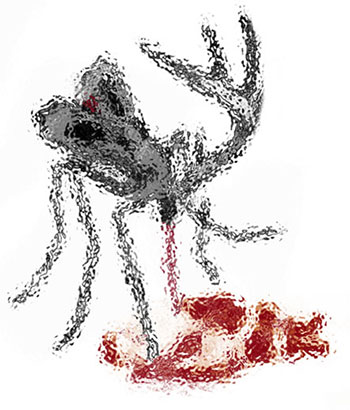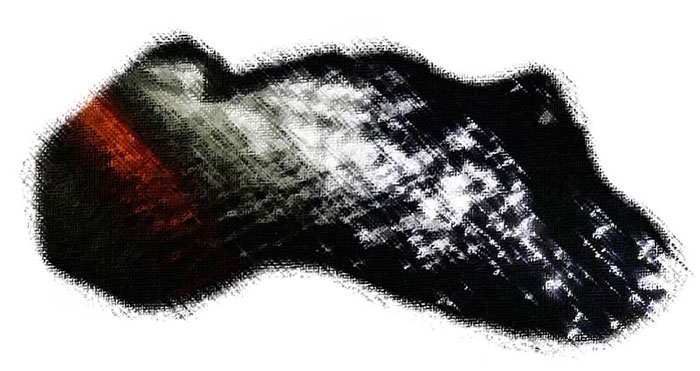NPE team researcher Joonas Vola reflects on a seminar that previously took place at the University of Lapland with the aim to understand and adjust the issue of Arctic Aesthetics!

 Sensation on skin … ‘Iiiiiiii-iIiiiII-IIIiiii-iiIIiii’ … small dark figure lands on a canvas … quick slap, and the white background has a bright red mark on it. “What an abject little creature; it made me stain the pure fabric!” Would you associate this description as an aesthetic experience of the Arctic?
Sensation on skin … ‘Iiiiiiii-iIiiiII-IIIiiii-iiIIiii’ … small dark figure lands on a canvas … quick slap, and the white background has a bright red mark on it. “What an abject little creature; it made me stain the pure fabric!” Would you associate this description as an aesthetic experience of the Arctic?
A seminar, arranged under the Developing Destination Experiences course in the University of Lapland 27th of October 2015 by the Multidimensional Tourism Institute, had the aim of adjusting an understanding or at least offering some new opening in addressing the issue of Arctic Aesthetics. Presenters in the seminar where the guest lecturer, Professor of Work and Organisation Philip Hancock from the University of Essex, Essex Business School; Professor of cultural economy Anu Valtonen from the University of Lapland and myself (researcher Joonas Vola) from the Northern Political Economy team. The presentations gave a vast variety of topics: histories of Christmas and the Arctic in fiction, servicescapes* of commodified sleep, science exhibition pieces, and in general in the globalized imaginaries of the Arctic in business, science and popular culture.
From all the different approaches and conceptualization I would like to draw three unifying themes based on the elements related to the understanding of the aesthetics of the Arctic: ascetics, imaginaries and animals. Freely interpreting Professor Hancock’s presentation on the purity and abjection, the pure is an ascetic quality, lacking the “landscaping; phenomenon caused by intentional purpose of human being”, and this lack is present in the Arctic surroundings, at least for the Western(ized) gaze. One very straight forward example of such aesthetic element could be untouched pure white snow cover. As much as this pure whiteness resembles ‘tabula rasa’ as a starting point, it seems to suggest that some strongly contrasting element will inevitably appear on it, draw its mark, simultaneously changing in a very drastic way the interpretation of what used to be there in the begin with. The beauty of purity seems to have become (or that it has secretly always been) just a highlighting background element for something unpleasant, repulsive and abject. Abject, in its severity, can also be understood as ascetic feature.
The ascetic in a way is a playground for the imaginary, which are both present in the order of sleep. Professor Valtonen in her presentation on Arctic sleep presented various examples from empirical cases, one of which showed how in the tourism outdoors dwelling and sleeping, the plain snow wall was carved to function as, and to resemble the aesthetics of home, western housing standards applied from our learned imaginary on the pure untouched (by humans) snow. Problematically, escaping society to asceticism, but still without leaving our imaginaries behind, would that still transfer the same magnificence/malice of the society to the new environment?
Instead of changing to a new surroundings, should we concentrate on changing ourselves and our way of being in the current surroundings? This non-human element is the third element which seemed to be in the core of the arctic aesthetics. The animal is present in the folklore and contemporary/alternative forms of Santa Claus, and appears already in the Finnish version of the name ‘Joulupukki’ (directly translates to Christmas-goat). Mosquitos are used in the anti-commercials of Finnish Lapland, and the polar bear has become the global icon of the Anthropocene climate change. In my presentation concerning the scientific representations of the Arctic especially in the science exhibitions, the presence of animals can be decoded from the etymology of Arctic, from the ecological and cultural oriented exhibition pieces as well as from alternative methods, such as the participatory environmental art performance ‘Reindeer Safari’*, which all are eventually highly sensory experiences (and therefore belonging to the aesthetics). Transforming nature vs. transforming oneself is materialized for example in the comparison of worn-out fur of the exhibition (animal)piece, consumed by the visitors, and the ‘Reindeer Safari’ where through bodily art performance the alternative ways of moving in the landscape also de- and reterritorializes* the urban city space.
Since the aesthetics is something which includes sensory aspect, sensations and feelings, evaluations, and societal norms, it appears to me that we cannot separate the human from the Arctic when we discuss about its aesthetics. Even though it would be the ‘nature’, or the ‘animal’, as long as it is turned into images and imaginaries, it is already pre-negotiated for us to be perceived and consumed.

*see for servicescapes: Booms, BH; Bitner, MJ (1981). Marketing strategies and organisation structures for service firms. In Donnelly, J; George, WR. Marketing of Services. Chicago, IL: American Marketing Association.
*see for ‘Reindeer Safari’, Other Spaces live art collective: http://toisissatiloissa.net/reindeer-safari/
* see for deterritorialization and reterritorialization: Deleuze, G. and Guattari, F. (1994). What is philosophy? London: Verso.
Text and Pictures: Joonas Vola